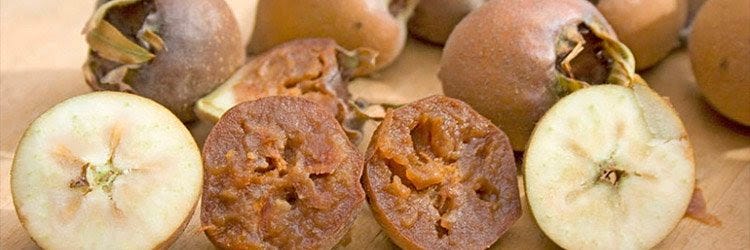Good morning. Long time, no see.
Bletted medlars sounds like a slur your Irish grandmother might have used, but it in fact describes the super-ripe state (bletted) of an ancient, once very popular, fruit (the medlar).
First, let me say: I’ve never tasted a medlar, or even ever seen one in person. And I’d never heard of one until a week or two ago. But, as I’ve done for the past several years when a fruit I’ve never heard of comes to my attention, I’ve done a good bit of research.
Here’s a tip sheet with the most interesting medlar details:
-The medlar tree is in the Rosaceae, or rose, family, which also includes the plants bearing apples, pears, stone fruits (peaches, cherries, etc.), quinces, loquats, strawberries, blackberries, raspberries, and, of course, roses.
-When they were at the height of their popularity in Europe from around the Middle Ages to the 1600s, medlar fruits were referred to by such names as “open-arse” and “cu d’singe” (monkey’s ass), owing to their pronounced calyx that somewhat resembles a certain mammalian orifice.
-Medlar trees were first domesticated in their native western Asia around 3,000 years ago, and they only seem to have really fallen off the map of big fruit players in the 1950s, when the fact that they were an autumn fruit, once a big draw, no longer made them stand out in the face of efficient refrigeration and transportation of other sturdier and more desirable fruits.
-“Bletting” is a term coined in the mid-1900s to describe the process by which medlars mature to their edible state. It denotes something well beyond ripening, bordering on rotting. The fruits must either endure the first frosts on the tree or be left to blet in a bed of straw in the orchard for several weeks, during which time starches are converted to sugars and acids and tannins are mitigated. The process transforms the fruit’s flesh from repellently firm and astringent to “ultra-sweet…with a complex flavour, like over-ripe dates mingled with lemons” (The Frontier Post) and perhaps a hint of apricot. The transformation is similar to that which occurs when a Hachiya persimmon is left to blet (yes, that’s what we do with persimmons as well to get them to their water-balloon-overripe state of perfection).
Have you eaten medlars? Have you cooked with them? According to this NY Times article from 2004, there are some growers in the U.S., (I checked, and at least one of these farms still produces medlars), and I’m going to try to get my hands on some before the season is over!
One last thing: Thanksgiving dessert recommendations from Good & Sweet: Pear & Almond Tart, Apple Custard Tart, Spiced Pumpkin Pie, Derby Date Pie, Persimmon & Spice Bundt Cake, Persimmon Panna Cotta.
Have a good week and a happy Thanksgiving. Talk to you soon.
Brian
P.S. Holiday idea: my book, Good & Sweet, is available signed at several independent shops, but if you order it from somewhere like Amazon (where it happens to be only $29 at the moment), I’d be happy to send you a signed book plate (that’s a sticker), with a dedication if you wish, for you to affix to the title page. Just send me an image of your receipt as well as your address and to whom (if anyone) you’d like me to address the note.
P.P.S. I think you know, but I’m on Instagram at @bybrianlevy
A note to you: Thank you for reading this. Feel free to respond (with questions, comment, suggestions), not respond, unsubscribe, whatever (You’re most welcome here, but I know how inboxes can get).
Photo credit: Los Angeles Daily News


